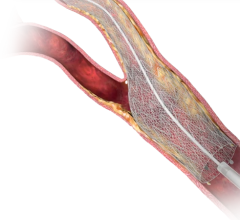
DynamX Coronary Bioadaptor System
February 16, 2022 – Elixir Medical, a developer of innovative, drug-eluting cardiovascular devices, has announced completion of enrollment in the BIOADAPTOR randomized controlled trial (RCT). The BIOADAPTOR RCT is evaluating the DynamX Coronary Bioadaptor System, the first drug-eluting coronary artery implant that adapts to vessel physiology, allowing for the restoration of normal vessel functions essential to cardiovascular performance.
The BIOADAPTOR RCT is a multicenter, randomized, single-blind study enrolling 444 patients from 35 centers in Japan, Europe and New Zealand treated with the DynamX Bioadaptor in a 1:1 randomization to Resolute Onyx, a leading drug-eluting stent (DES). The primary endpoint of the study is target lesion failure (TLF) at one year. Secondary endpoints include measures of the implant’s ability to accommodate vessel growth from disease progression and restore vessel pulsatility in an imaging subset, as well as the incidence of major cardiovascular events.
“The bioadaptor is a revolutionary innovation in percutaneous coronary intervention and we are enthusiastic about studying the device’s ability to accommodate and restore vessel movement and function,” said Shigeru Saito, MD, Director of the Cardiology and Catheterization Laboratory at Shonan Kamakuru General Hospital, Kanagawa, Japan, and principal investigator of the BIOADAPTOR RCT. “Despite the challenges presented by the COVID pandemic, we are proud that we were able to enroll the trial in about one year.”
The DynamX Bioadaptor is designed to address the continuous major adverse cardiac event rate that occurs with drug-eluting stents (DES) each year without plateau.1,2,3 The rigid design of a DES constrains, or “cages,” natural artery functions, restricting its ability to expand, contract and rotate with each heartbeat, as well as accommodate disease progression. This has been associated with major adverse cardiac events (MACE).4 Long-term studies have shown adverse event rates associated with DES of 20 percent at five years and 40 to 50 percent at 10 years.2 Clinical studies have demonstrated that a DES prevents positive adaptive remodeling,5 inhibits vessel pulsatility and dilation in response to the body’s changing blood flow needs,6,7 and causes vessel straightening, which has been associated with increased MACE.8
By incorporating unique “uncaging elements” in its metallic implant design, the DynamX Bioadaptor allows for the restoration of natural artery function and movement9 essential to cardiovascular performance. The DynamX Bioadaptor is designed to improve clinical outcomes by adapting to vessel physiology and restoring positive adaptive remodeling, pulsatility and rotation.
The DynamX Bioadaptor supports the coronary artery with radial strength and acute performance similar to DES during healing. The drug-eluting polymer coating resorbs over six months and the device then “uncages,” allowing the artery to move naturally in response to the body’s needs.
The DynamX Coronary Bioadaptor System is CE Mark approved. Not available for sale in the USA.
For more information: elixirmedical.com/us/
Also read First Patient Treated in Elixer Dynamx Coronary Bioadaptor Stent Technology
References:
- Iqbal J, Serruys PW, Silber S, et al. Comparison of zotarolimus- and everolimus-eluting coronary stents: final 5-year report of the RESOLUTE all-comers trial. Circ Cardiovasc Interv. 2015;8(6):e002230. doi:10.1161/CIRCINTERVENTIONS.114.002230
- Kufner S, Joner M, Thannheimer A, Hoppmann P, Ibrahim T, Mayer K, et al. Ten-year clinical outcomes from a trial of three limus-eluting stents with different polymer coatings in patients with coronary artery disease: results from the ISAR-TEST 4 randomized trial. Circulation. 2019; 139:325–333. doi: 10.1161/CIRCULATIONAHA.118.038065.
- Smits, PC, Valchojannis, GJ, McFadden, EP, et al. Final 5-Year Follow-Up of a Randomized Controlled Trial of Everolimus- and Paclitaxel-Eluting Stents for Coronary Revascularization in Daily Practice. J Am Coll Cardiol Intv. 2015 Aug, 8 (9) 1157-1165.
- Stone GW, Kimura T, Gao R, et al. Time-Varying Outcomes With the Absorb Bioresorbable Vascular Scaffold During 5-Year Follow-up: A Systematic Meta-analysis and Individual Patient Data Pooled Study. JAMA Cardiol. 2019;4(12):1261–1269. doi:10.1001/jamacardio.2019.4101
- Nakamura M, Yock PG, Bonneau HN, et al. Impact of peri-stent remodeling on restenosis: a volumetric intravascular ultrasound study. Circulation. 2001;103(17):2130-2132. doi:10.1161/01.cir.103.17.2130
- Maier, W, Windercker, S, Kung, A, et al. Exercise-Induced Coronary Artery Vasodilation Is Not Impaired by Stent Placement. Circulation. 2002; 105(20): 2373-2377. doi: 10.1161/01.cir.0000016360.97819.44
- Hamilos, M, Sarma, J, Ostojic, M, et al. (2008). Interference of Drug-Eluting Stents With Endothelium-Dependent Coronary Vasomotion Evidence for Device-Specific Responses. Circulation. Cardiovascular interventions. 1. 193-200. 10.1161/CIRCINTERVENTIONS.108.797928.
- Gyöngyösi M, Yang P, Khorsand A, Glogar D. Longitudinal straightening effect of stents is an additional predictor for major adverse cardiac events. Austrian Wiktor Stent Study Group and European Paragon Stent Investigators. J Am Coll Cardiol. 2000;35(6):1580-1589. doi:10.1016/s0735-1097(00)00570-2
- Verheye S, Vrolix M, Montorfano M, Zivelonghi C, Giannini F, Bedogni F, et al. Twelve-month clinical and imaging outcomes of the uncaging coronary DynamX bioadaptor. EuroIntervention 2020;16;e974-e981
- Kansal, M, Wolska B, Verheye, S, Vidovich, M. Adaptive coronary artery rotational motion through uncaging of a drug-eluting bioadaptor aiming to reduce stress on the coronary artery, Cardiovascular Revascularization Medicine, 2021.


 November 24, 2025
November 24, 2025 









